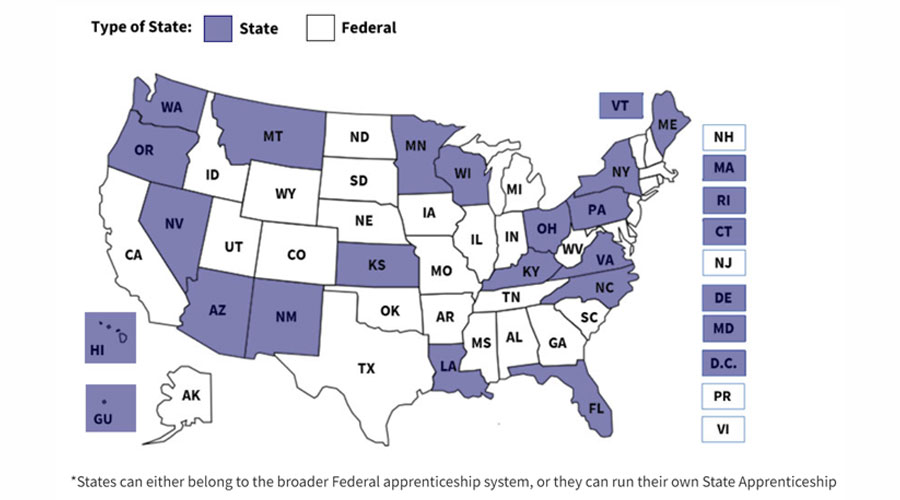Recently, I attended an Apprenticeship Meeting at Wake Tech Community College to hear more about “Debt-Free Education.” I listened to the speakers discuss the industry workforce shortages in manufacturing, electrical, HVAC, welding, plumbing, construction, etc. I began pondering how we could use apprenticeships to address workforce gaps in the A/E industry. Specifically, I wondered if an apprenticeship program was right for my company, Summit Design and Engineering Services.
It is no secret that fewer individuals are entering into trade positions even though trade work is not slowing down. At some point, we will have a major shortfall of qualified individuals. Perhaps apprenticeships are the answer.
What is an Apprenticeship?
An apprenticeship is an industry-driven, high-quality career pathway where employers can develop and prepare their future workforce through on-the-job learning while individuals obtain paid work experience and classroom instruction.
The apprenticeship model dates back to the 18th century. In Egypt, apprenticeships allowed communities to maintain their numbers of craftsmen. In Babylon, artisans were required to teach the next generation their crafts. By the 13th century, western Europe had adopted the apprenticeships model through the form of craft guilds.
Why do an apprenticeship?
Why Are Apprenticeships Valuable to a Company?
By hiring a pre-apprentice or an apprentice, you invest in that individual’s career and future, not to mention adding skilled employees to the workforce. This is more than just a win-win partnership. It is also the most useful recruitment and retention tool in your company’s toolbox! Based on data from the Department of Labor, 91% of apprentices that complete an apprenticeship are still employed nine months later.
By investing in this employee, you can reduce your turnover rates and keep the company’s recruitment costs down.

What are Some Options for Apprenticeships for a Civil Engineering or Architectural Firm?
Depending on the services offered by your company, there are several options to think about when developing an apprenticeship program. Some positions to consider would be:
- Drafters
- Designers
- Field or Lab Technicians
- Survey Instrument Operators
- Construction Inspectors
- Corporate Level Positions
For example, Summit’s first registered apprenticeship grew from a desire to have a current employee, who had been with us a year as a Lab Technician, become a Field Technician. This seemed like the perfect opportunity to create and experiment with an apprenticeship program, so we worked with ApprenticeshipNC to create an apprenticeship opportunity for this employee. Through the program, this employee will obtain his Civil Engineering Technology Degree from Wake Tech Community College while he is working full-time, earning a salary including a full employee benefits package, obtaining state/national certifications, and gaining real-world experience. There is also an opportunity for him to be promoted once he finishes the program. This employee also has their tuition, fees, and book costs taken care of through a state grant program. In an age of gripping student debt, this is yet another benefit to an apprenticeship program.

How Do You Start an Apprenticeship Program?
To get started, follow the steps below:
Assess your workforce.
Identify if there is a need for an apprenticeship program within your company. Ask yourself a few questions.
- Does an apprentice fit into your business strategy?
- Is there a growing need for a particular position at your company, which could be fulfilled through an Apprenticeship Program?
- Is your company facing workforce challenges through attrition or retirement?
- Has it become difficult to find employees with the right skills or certifications, or has your company had difficulty attracting new and diverse employees?
If your answer to these questions was yes, then continue on the apprenticeship path!
Design, build and register the program.
You will want to work with your local Apprenticeship agency to help you build this program and complete the proper documentation. Some general items that will be required to build this program are:
- Create a structured on-the-job-training checklist that the apprenticeship(s) will utilize to work through the program.
- All apprentices will be assigned a mentor. Selecting the best mentor for your program and the apprentice are key, along with establishing other vital roles and responsibilities within the program.
- Establishing the related instruction to complement the on-the-job training. This will deliver the technical and academic competencies that apply to the job that the apprentice is performing. This related instruction can be provided by a community college, technical school, an apprenticeship training school, or your company itself.
- Creating a wage progression for the apprentice. Some companies provide increases throughout the program, but at a minimum, what they are paid upon entry into the program and what they are paid when they complete the apprenticeship needs to be established.
- Develop a performance matrix to track the apprentice’s performance throughout the program.
Depending on your state, you will register your program with either the U.S. Department of Labor’s Apprenticeship or a Department of Labor recognized State Apprenticeship Agency. Be sure to utilize this agency to help you establish your program, especially if you have never gone through the process before. See the map below as a reference on who you would contact, or visit the map here:

To access the interactive contact map above for your state, click here.
The apprenticeship program bolsters a workforce with less risk and more reward. This program provides on-the-job training specific to your company and industry, so the apprentice is fully trained upon completion of the program. They will be a more productive and higher performing employee, leading to happy clients and repeat business for you. Hopefully, after reading this, you will begin to think of ways that an apprentice could benefit your company. Remember, “investing in your workforce today can prepare your business for success in the future.”
The following sources were utilized to create this blog and can be used as additional resources if you are ready to establish an apprenticeship program.
- Apprenticeship USA Planning Tool
- https://www.dol.gov/apprenticeship/ toolkit/toolkitfaq.htm#2a
- https://www.britannica.com/topic/ apprenticeship
- https://www.apprenticeship.gov/become-apprentice
- https://www.apprenticeshipnc.com/ employers
- https://www.visualworkforce.com/blog/4-key- reasons-to-grow-your-workforce-internally)
